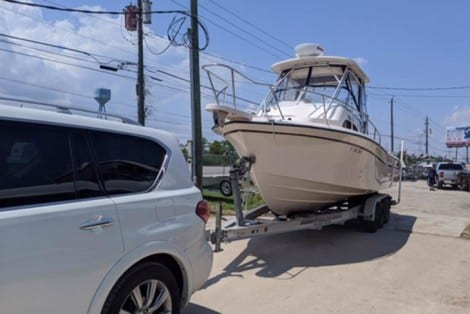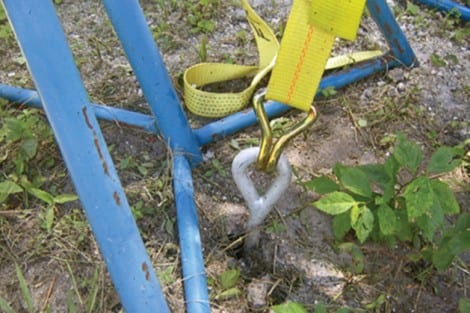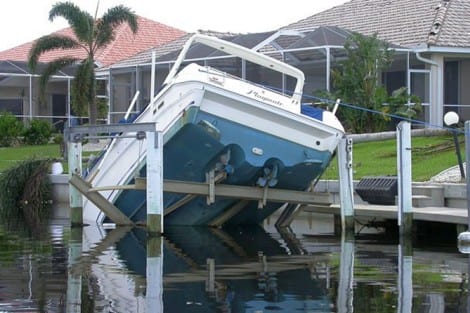 By Bob Currie, Recreational Boating Safety Specialist
By Bob Currie, Recreational Boating Safety Specialist
U. S. Coast Guard Auxiliary Station Galveston Flotilla
For most people who live on a coast, whenever a large storm is imminent there is one major question to be answered. That question can be found in a song by The Clash, Should I Stay or Should I Go:
Should I stay or should I go now?
Should I stay or should I go now?
If I go, there will be trouble
And if I stay it will be double
So come on and let me know
Should I stay or should I go.
The Station Galveston Flotilla of the US Coast Guard Auxiliary operates out of the USCG Station Galveston base on Galveston Island. They aid the Coast Guard by providing maritime observation patrols in Galveston Bay; by providing recreational boating vessel safety checks; and by working alongside Coast Guard members in maritime accident investigation, small boat training, providing a safety zone, Aids to Navigation verification, in the galley, on the Coast Guard Drone Team and watch standing.
Along with this personal decision, boat owners have another concern: what to do about our boats. This column will deal with storm options for boats. I don’t call it a hurricane plan because it doesn’t take a full blown hurricane to destroy your boat if precautions are not taken to protect it from wind, rain, and surge. For this column I am using the BoatUS Hurricane Center as a source for recommendations.
Boat Insurance
I have talked to a few boaters who say they aren’t worried about their boats because they have insurance. That is not a good attitude to take for a few reasons. First, many, if not all, boat insurance companies require boat owners to have a storm plan and expect them to follow it. For instance, the plan I filed with my boat insurance says that I will trailer my boat north away from the storm. That’s an easy option for me as my boat is quite trailerable behind my truck. It’s not an easy option for large boat owners, though. The key take-away here is that your insurance may not cover you unless you take reasonable precautions. They don’t want to pay for storm loss and are a very good source for information on how to protect your boat. My insurance company sent me an email letting me know that I was in the path of two storms and reminded me of my promise to trailer my boat to a safe location. If you don’t have a formal hurricane plan, as they are called, you need to create one, and your insurance company is one of the best places to go for advice. My insurance company will even pay half of the cost to haul my boat out (up to $1,000) and have it removed to a safe location. Another source for storm preparation is the BoatUS Hurricane Center https://www.boatus.com/hurricanes/boaterprep.asp .
Trailering Out
This option is for the recreational boater whose boat is small enough to load onto a trailer and haul behind their personal vehicle. I have seen some pretty large boats hauled behind the typical regular-sized pickups and SUVs. The bigger the truck, the larger the boat you can safely trailer out.

Coast Guard Auxiliarist Glenn Colaco trailering his offshore boat out.
The first part of the trailering out process is to retrieve your boat out of the water and onto your trailer. Many people in my area keep their boats on lifts behind their houses (we call them cabins down here on the Gulf of Mexico). Their trailers are often stored at another location, and they have to go get the trailer. The trailer may have been sitting unused for years, so it is important to make sure the bearings are freshly lubricated (if not sealed bearings), the lights work, and the trailer bunks are not deteriorated.
The second part of the trailering out process is to retrieve your boat from the water. Don’t try to do it yourself. Get a friend. Also, don’t wait until the last minute, as you may find the ramps inaccessible due to rising tides or heavy waves. You may also find a long line of boaters trying to retrieve their boats.
The third part of the trailering out process is to have a place to trailer the boat to. This is why it is important to prepare a plan for storms. If you wait until the last minute to call someone and ask if you can let you park your boat in their driveway for a few days, that option just might not be available.
Strapping Down Boats Ashore
One option is to store your boat ashore if you have no place to trailer the boat to. The key to this option is to securely strap the boat down using straps that are anchored securely into the ground with helical anchors. While boats ashore generally suffer less damage than boats at docks, they can suffer severe damage if not properly secured. If the boat is not securely strapped down, the boat will rock in the wind and work loose or rock violently. The result can be cracked hulls and broken bulkheads.

Well-anchored shore tie down. Source: Boat US Hurricane Center
Storing Boats in Canals
Despite the considerable advantages, many boats in canals have been damaged in recent hurricanes. Most were on lifts or at docks where they were still vulnerable to high winds and the surge. All it took in a canal was one or two boats breaking loose to damage a lot of other boats. If you live on a canal and have your boat stored on a lift, you need to lower the boat and secure it to your dock. One method of preparing your boat to weather the storm is to anchor it in the middle of the canal. I won’t go into the methodology here; you can go to the BoatUS Hurricane Center for a complete description of the process, but the most important thing when using this method is to use anchors that won’t be pulled up by the surge and use enough lines to secure the boat. New lines. Those lines that have been sitting in a locker for 10 years probably won’t last long with heavy winds.
Dry-Stack Storage
Many people in my area use dry-stack storage routinely for their boats. Whenever they want to take a boat ride, they call the dry-stack facility in advance, and the facility will pull their boat from storage, put it in the water, and have it ready to go. One advantage of dry-stack storage is you don’t get any barnacle or vegetation buildup on your hull. How do dry-stack storage facilities stack up during a storm? If it was built after Hurricane Andrew (1992), the answer is pretty good. Even so, a dry-stack facility in Galveston collapsed and burned during Hurricane Ike. Ask your dry-stack facility what wind strength their dry-stack facility is rated for. If the expected winds are higher, you may want to think about moving the boat to another location by trailer, if trailerable, or by a boat moving company if not trailerable.
Marina Storage in the Water
The best marinas have floating docks and high pilings, typically 16 to 18 feet tall. Floating docks allow the boats to rise and fall with surge without stretching and stressing lines. The most important things to consider when securing your boat at a marina are to use new lines, use many lines, and use chafing gear so the lines don’t part due to rubbing against the dock. If your marina is well sheltered and has floating docks with high pilings, your storm plan may be to strip anything that creates windage and add extra lines. Doubling all lines plus adding new lines is a good start. How key is it to have tall pilings? See for yourself what happens when the surge hits.

Source: BoatUS Hurricane Center
Summary
The key to saving your boat from storm damage is preparation. You can’t wait until a storm that is headed your way is given a name and a storm warning is issued. You must stay on top of the weather if you live on the coast, and you must have a storm plan for your boat. It can’t just be the last item in your personal protection list (“15. Take the boat to Uncle Charles’ house.) There are several ways to deal with an approaching storm, and the method you choose is dependent on your ability to move your boat or secure it in place. Your insurance company is a great source for storm preparation, as is BoatUS Hurricane Center, found at
https://www.boatus.com/hurricanes/boaterprep.asp.
For more information on boating safety, please visit the Official Website of the U.S. Coast Guard’s Boating Safety Division at www.uscgboating.org. Questions about the US Coast Guard Auxiliary or our free Vessel Safety Check program may be directed to me at [email protected]. SAFE BOATING!
[July-19-2021]

 Posted in
Posted in 
























